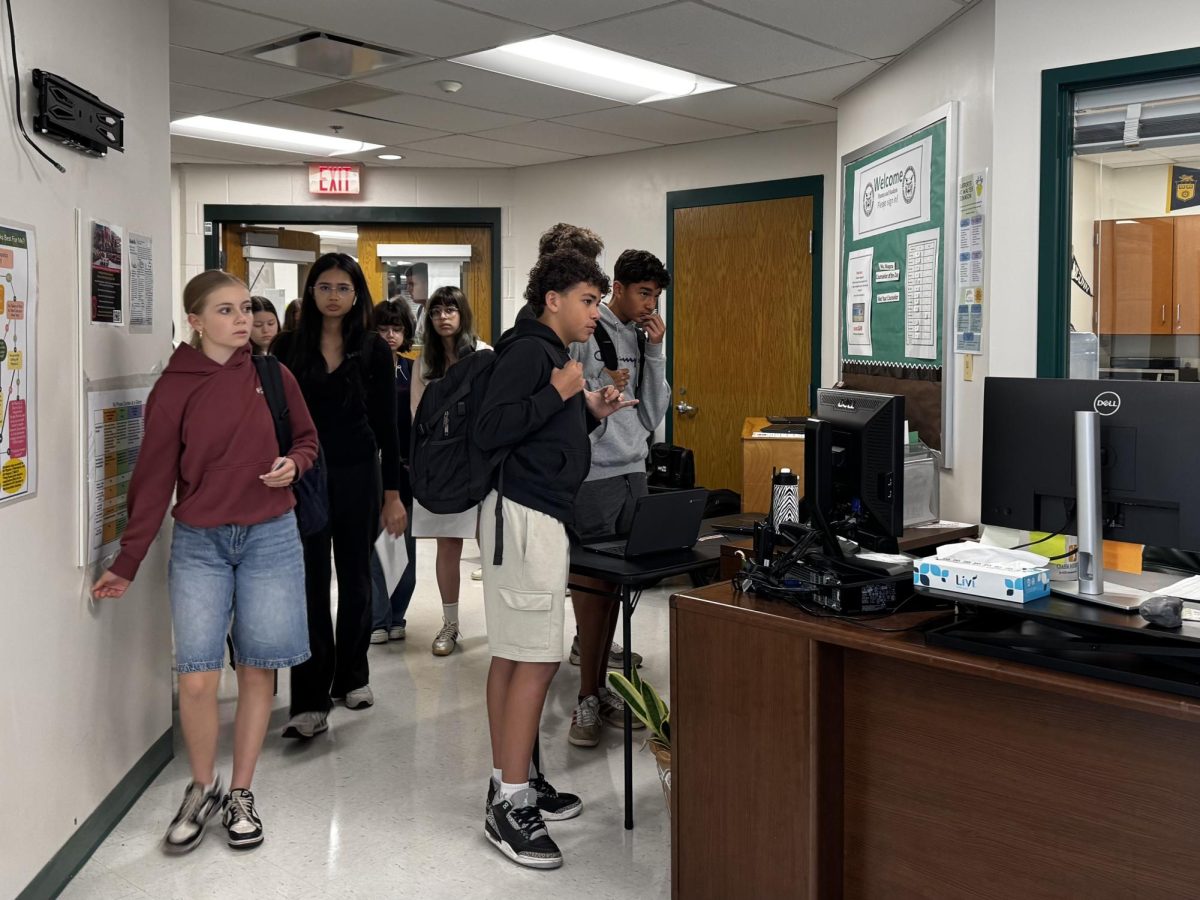*This article has been corrected since published.
Broadcasting live to students every morning during second period, “The Daily Lineup” is a part of the WJ community. Although many students perceive the daily dose of broadcasted announcements as nothing more than school news, to the cast and crew of the show, there is much more than what meets the eye.
Senior Mike Mapes, an anchor, has been a part of the production since his junior year. Mapes’ way into the show was through the TV Production Club, assisting Ty Huber, who runs “The Daily Lineup.”
“More or less, I’m just a relatively talented speaker, so I figured why not [try an anchor position]?” said Mapes.
After auditions, which are only held for potential anchors, Mapes was confident he would get a spot.
“Frankly, this year’s contestants weren’t terribly good,” said Mapes, who added that being able to read well and speak clearly were the only necessary skills coming into auditions, as the other skills could be learned later. “All the current anchors, myself included, were able to do this comfortably in the try outs, all those who tried out and couldn’t simply didn’t make it.“
During the anchor audition process, candidates are given a mock script. They are then asked to read it on camera. According to junior Gabe Jacobsohn the show’s director, these auditions are one of his favorite parts of being on the show.
“[It is] just because there are so many fails at that point, and when nobody’s watching it, you can actually stop and joke around about it, which just makes it really enjoyable,” he said.
At the beginning of each school year, a meeting is held, which is used to orient people new to “The Daily Lineup” to the workings of the show. Students who do not audition to become anchors begin work on the show by attending tapings and observing others.
“[Attending tapings are important so] students can get a sense of how things work,” said Jacobsohn. “Then as the year goes on [we] can put [students] in some positions.”
After a student assumes a position, it is up to Jacobsohn and technical director, junior Noam Lautman, to decide who will move up the ranks.
“[We’ll] see how well you can handle everything, and if you’re good at that, then [we’ll] move you up,” said Jacobsohn. “If not, [we’ll] keep you on the small jobs.”
While the other positions on the show are technical and behind-the-scenes, the anchors have the responsibility of conveying news to the student body, in an error-free fashion, despite any technical mishaps that may arise.
“Basically, the script isn’t always accurate or grammatically correct,” said Mapes. “One of our biggest responsibilities is to fix it as we read it. Occasionally we stutter doing so. Other than that we just need to remain respectable and not insult anyone.”
The script is composed of various announcements sent in from teachers and administrators regarding upcoming club meetings, fundraisers or other school events.
In order to help the anchors, who alternate reading announcements, they have a teleprompter, which allows the anchor to read the script and look into the camera simultaneously. They also have a color-coded paper script.
Right after first period ends, the cast and crew hurry down to the television production studio, located in a backroom of the media center. Within the cast and crew, there are more than two anchors. According to Mapes, whichever anchors get to the studio first usually are the anchors for that particular show. The three cameras, left, right and center, must also be positioned by this time. One person manages each camera. However, Jacobsohn says the technology doesn’t always run smoothly.
“We have a lot of problems with people [who] don’t really know their directions,” he said. “So I’ll say ‘pan left’ and they will go down and [to the] right.”
Jacobsohn says that one of his most challenging responsibilities is managing the show when things “go horribly wrong.” He recalls an incident where the show went on air without the correct script. Left with nothing to read, the anchors had to improvise.
“In that situation, you just have to think of something to do, like fading to black, and making sure nothing else goes even more wrong,” he said. “Not while we’ve been here, but a few years back, they had people that were making jokes and started cursing and making racist comments. That’s what you want to avoid.”
Jacobsohn and Lautman have worked on the show since their freshman year. According to Jacobsohn, the S*T*A*G*E and “The Daily Lineup” crews are closely intertwined. By meeting people who worked on S*T*A*G*E’s productions, they were also introduced to the show.
Jacobsohn also had previous news and television experience from working on Tilden Middle School’s announcements. Many of the students who work on “The Daily Lineup” are in WJ’s TV Production Club, but not all are. During any one show, Jacobsohn and Lautman approximate there to be around 18 to 20 people in the television studio.
During the show, Jacobsohn sits in the back studio, where the switchboard is run. The switchboard changes the focus onto each camera, as well as the microphones. Jacobsohn is in direct communication via headset with the floor manager at all times. Once the show intro and theme song are played, the announcements are made, followed by the customary SAT word of the day and pledge of allegiance.
The show’s intro, which is composed of various video clips and a song, was created by Jacobsohn at the beginning of the year.
“[The intro is] always a last minute process, when it’s never supposed to be,” he said. “Most of the footage [included] in that is just from the beginning of the year, so I always say that I’m going to make a new one at some point in the middle of the year, and it’s never happened.”
Although the show, which runs for approximately five minutes with relatively short set up and clean up times, may sometimes be stressful, Mapes says he enjoys being a part of the show.
“[My favorite part] is probably the joke at the end,” he said.
Mapes typically closes the show with a joke he makes up, sometimes on the spot. In addition, Mapes particularly enjoys co-anchoring with fellow senior Madison Chase, due to her anchor experience.
Junior Nelly Gorodetsky, also an anchor, joined the crew during this school year. Gorodetsky decided to join the show because it seemed fun and interesting.
“You see anchors on the actual television and I thought it was always so interesting to have our own morning announcements,” she said.
Although the responsibility of reading the news, broadcasted to the entire school, may not be appealing to students on the quieter side, Gorodetsky says, ironically, that she is afraid of public speaking.
“But I love public speaking at the same time,” she said. “I’m afraid of giving speeches, but I always search for opportunities to give speeches.”
According to Gorodetsky, before the show starts, the anchors typically read over the scripts, looking for any words that may be difficult to pronounce or announcements that may be old.
Gorodetsky says that one of the most difficult parts of being an anchor is reading the longer blocks of announcements.
“[I am] just sitting there and talking and talking, and running out of air,” she said.
Over his time working with “The Daily Lineup” crew, Jacobsohn has learned that he must expect and anticipate that things will go wrong, in order to prepare for these mishaps. He also says that he has learned to manage people.
“If you don’t give people very, very specific instructions, they’re going to do it wrong,” he said.
Lautman also anticipates the mistakes and errors that will come up during the show.
“I’m in bed, and I’m about to fall asleep and then I think of everything that could go wrong, and I think of how it can be fixed,” he said, joking. “I think it’s only me, only I would do that.”
But all humor aside, Jacobsohn recognizes that sometimes he must make the executive decision and stop the show, or continue the show without a broken or malfunctioning component, such as a camera or script.
“At some point, if you’re trying to fix something [and] it’s just not working, sometimes you just have to make the call and say ‘Okay, stop fixing it’ because [if] we fade to the camera and someone’s at the [television] fiddling with it on-screen it looks just dumb,” he said.
Apart from all of the errors and mishaps they must deal with, Jacobsohn and Lautman say that working on “The Daily Lineup” has overall been a positive experience. In fact, when the show is in a state of disorder, the fun really begins.
“The times when [the show is] not organized is when it’s the most fun, because otherwise you’re just settling into a routine, it gets boring,” said Jacobsohn.
Lautman explains that the crew bonds over the moments where things don’t go as planned.
“When things go wrong, at the moment, everyone is going crazy,” added Lautman. “But
afterwards, when we walk to class, we’re like, ‘Did that really just happen?’ Then the next day you come in and say ‘That was the worst thing we’ve ever done,’ and then you laugh about it.”








